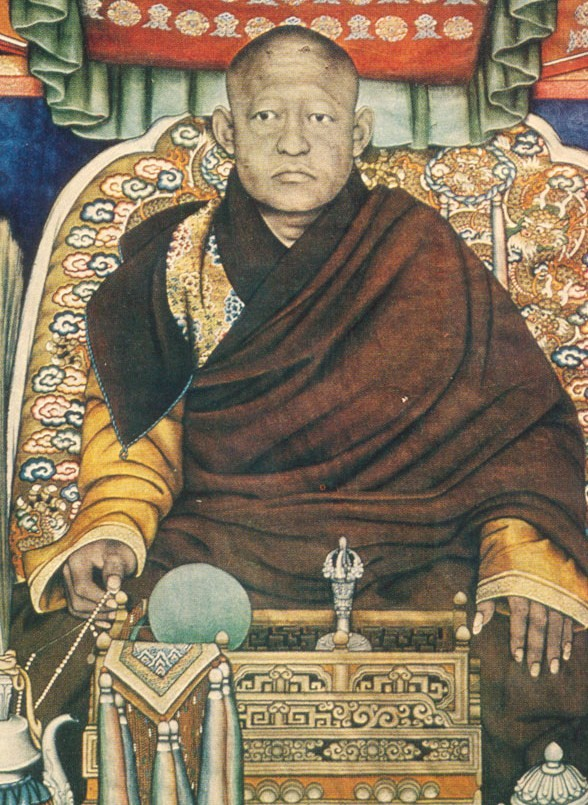Agvaan Luvsan Choijinnyam Danzan Vanchüg: Difference between revisions
More languages
More actions
(Redirect) Tags: New redirect Visual edit |
mNo edit summary Tag: Visual edit |
||
| (One intermediate revision by the same user not shown) | |||
| Line 1: | Line 1: | ||
{{Infobox politician|name=Agvaan Luvsan Choijinnyam Danzan Vanchüg|native_name=Агваанлувсанчойжинямданзанванчүг|image_size=200|birth_date=c. 1869|birth_place=Lhasa, [[Qing dynasty]]|death_date=1924 May 20|death_place=Niislel Khüree, [[Bogd Khanate|Mongolia]]|nationality=Mongolian|political_orientation=[[Feudalism]]<br>[[Buddhist]] [[Religious fundamentalism|fundamentalism]]|image=Bogd Khan.png}} | |||
'''Agvaan Luvsan Choijinnyam Danzan Vanchüg''' (c. 1869 – 1924 May 20), commonly known by the title of '''Bogd Khan''', was the ruler of [[Bogd Khanate of Mongolia (1911–1924)|Mongolia]] from its 1911 independence from the [[Qing dynasty (1636–1912)|Qing dynasty]] until the 1921 [[Mongolian People's Revolution]]. | |||
== 1911 revolution == | |||
After the Qing occupation of Mongolia was overthrown in 1911, the feudal [[nobility]] led by the Bogd Khan took power. [[Yuan Shikai]], the new ruler of [[Republic of China|China]], refused to recognize Mongolia's independence.<ref name=":0">{{Citation|author=A. A. Guber, et al.|year=1973|title=History of the Mongolian People's Republic|title-url=https://archive.org/details/HistoryOfTheMPR/page/n116/mode/1up|chapter=The National-Liberation Movement of the Mongolian People}}</ref><sup>:237–40</sup> The Bogd Khan confiscated the Qing royalty's herds and gave them to princes and lamas.<ref name=":0" /><sup>:251–4</sup> | |||
== Rule of Mongolia == | |||
The Bogd Khan sent [[Tserenchimed]] to [[Empire of Japan (1868–1947)|Japan]] and requested a Japanese protectorate over Mongolia, which Japan refused in order to avoid angering [[Russian Empire (1721–1917)|Russia]]. In 1913 February, Mongolia formed a brigade in the Russian army with 1,900 soldiers. The Bogd Khan withdrew his troops from Inner Mongolia in 1913, and Russia withdrew its troops from Outer Mongolia in 1914.<ref name=":0" /><sup>:240–7</sup> | |||
The Bogd Khan allied with the pro-Japanese Anhui clique of Chinese warlords, who invaded Mongolia in 1918. In mid-1919, after retaking the East, the Soviet government abolished all unequal treaties Russia had had with Mongolia. The Khan rejected the Whiteguard [[Grigory Semyonov|Semyonov]]'s plan to unify all Mongol lands into a single state that Japan could control, which collapsed in 1919.<ref name=":03">{{Citation|author=A. A. Guber, et al.|year=1973|title=History of the Mongolian People's Republic|title-url=https://archive.org/details/HistoryOfTheMPR/page/n116/mode/1up|chapter=The Mongolian People's Revolution and the Proclamation of the Mongolian People's Republic|page=}}</ref><sup>:272–5</sup> The [[White Army|White]] [[Roman Ungern-Sternberg|Baron Ungern]] allied with the Bogd Khan and defeated the Zhili clique in February 1921. Ungern executed the Minister for the Western Province and removed the War Minister from office.<ref name=":03" /><sup>:281–4</sup> | |||
== References == | |||
[[Category:Dictators]] | |||
[[Category:Former heads of state]] | |||
[[Category:Monarchs]] | |||
Latest revision as of 16:38, 2 June 2024
Agvaan Luvsan Choijinnyam Danzan Vanchüg Агваанлувсанчойжинямданзанванчүг | |
|---|---|
 | |
| Born | c. 1869 Lhasa, Qing dynasty |
| Died | 1924 May 20 Niislel Khüree, Mongolia |
| Nationality | Mongolian |
| Political orientation | Feudalism Buddhist fundamentalism |
Agvaan Luvsan Choijinnyam Danzan Vanchüg (c. 1869 – 1924 May 20), commonly known by the title of Bogd Khan, was the ruler of Mongolia from its 1911 independence from the Qing dynasty until the 1921 Mongolian People's Revolution.
1911 revolution[edit | edit source]
After the Qing occupation of Mongolia was overthrown in 1911, the feudal nobility led by the Bogd Khan took power. Yuan Shikai, the new ruler of China, refused to recognize Mongolia's independence.[1]:237–40 The Bogd Khan confiscated the Qing royalty's herds and gave them to princes and lamas.[1]:251–4
Rule of Mongolia[edit | edit source]
The Bogd Khan sent Tserenchimed to Japan and requested a Japanese protectorate over Mongolia, which Japan refused in order to avoid angering Russia. In 1913 February, Mongolia formed a brigade in the Russian army with 1,900 soldiers. The Bogd Khan withdrew his troops from Inner Mongolia in 1913, and Russia withdrew its troops from Outer Mongolia in 1914.[1]:240–7
The Bogd Khan allied with the pro-Japanese Anhui clique of Chinese warlords, who invaded Mongolia in 1918. In mid-1919, after retaking the East, the Soviet government abolished all unequal treaties Russia had had with Mongolia. The Khan rejected the Whiteguard Semyonov's plan to unify all Mongol lands into a single state that Japan could control, which collapsed in 1919.[2]:272–5 The White Baron Ungern allied with the Bogd Khan and defeated the Zhili clique in February 1921. Ungern executed the Minister for the Western Province and removed the War Minister from office.[2]:281–4
References[edit | edit source]
- ↑ 1.0 1.1 1.2 A. A. Guber, et al. (1973). History of the Mongolian People's Republic: 'The National-Liberation Movement of the Mongolian People'.
- ↑ 2.0 2.1 A. A. Guber, et al. (1973). History of the Mongolian People's Republic: 'The Mongolian People's Revolution and the Proclamation of the Mongolian People's Republic'.
